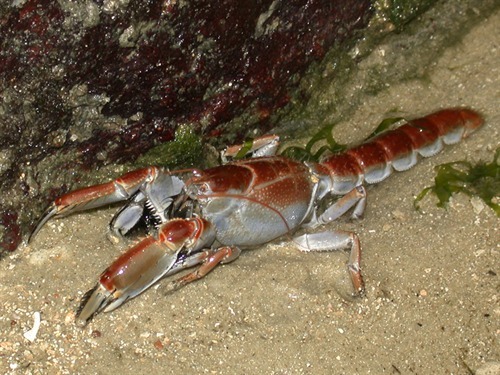
Back
Thalassina gracilis Dana, 1851
| Family Name: | Thalassinidae |
| Taxonomic Group: | Invertebrates (Crustacean, Crab and Prawn) |
| Common Name: | Mud Lobster |
Name
Ecology, Habitat & Location
| Ecological Notes | Adults are highly tolerant of the oxygen-poor conditions in the deep waterlogged mangrove mud, and excavate deep, extensive tunnel systems in back-mangroves that often extend inland beyond the mangrove fringes. The animal is rarely seen, but excavated mud is discarded as prominent heaps at the openings of the tunnels, forming volcano-like mounds which may reach two metres in height. They feed on the mud, extracting organic matter. |
|---|---|
| Habitats | Mangroves |
| Distribution | Throughout the Indo-West Pacific. |
| Nature Reserves | Sungei Buloh Wetland Reserve |
| Nature Areas | Kranji Nature Trail, Pulau Ubin |
Conservation
| Trends & Threats | Development and loss of mangroves. |
|---|---|
| Scientific Interest & Potential Value | Mud lobsters are very important animals in mangroves and help dig up and recycle nutrients otherwise locked up in anoxic mangrove mud. The large mounds also affect the landscape of mangroves by providing a habitat for many plant and animal species including the tree, Excoecaria agallocha; the shrub, Acanthus; the ant, Odontomachus malignus; the Mound crab, Sarmatium germaini; and the File snake, Acrochordus granulatus. Some rarely seen associated species such as the Mud shrimp Wolffogebia phuketensis are just as endangered as T. anomala. A second smaller mud lobster species with a pointed rostrum, T. gracilis, is also known from Singapore and was found only over the last decade living in mounds adjacent to the ones dug by T. anomala. Thalassina gracilis was originally described from a single specimen collected in Singapore; and was not seen again until it was rediscovered by local researchers. |
| Conservation Notes | The survival of the mud lobster is integral to the ecology of a healthy mangrove system, as many other species are closely associated with its survival. There is no effective means to conserve this species except by retaining extensive areas of mangroves in Singapore. |
Status
| Singapore Red Data Book Status | Endangered (EN) [2008] |
|---|
Photos
References
| References | Davison, G.W.H., Ng, P.K.L. & Ho, H.C (Eds.). 2008. The Singapore Red Data Book (2nd Edition). Singapore: Nature Society (Singapore). 285pp |
|---|

